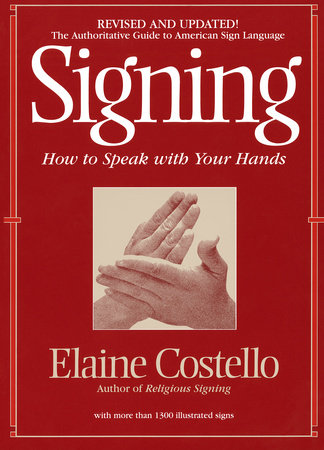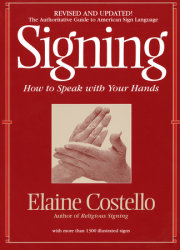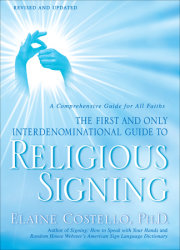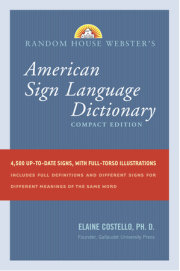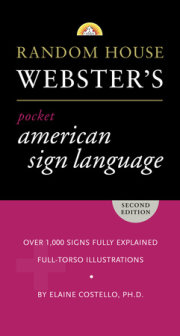Introduction
In recent years sign language has shown an amazing growth in popularity. Thousands of individuals of all ages are discovering that the study of sign language can be a fascinating and rewarding adventure. Signing: How to Speak With Your Hands is designed to assist you in learning this vibrant, expressive language that is used by Deaf people throughout North America.
This book makes sign language study easier in many ways. It presents manageable amounts of new sign vocabulary within logical topical groupings. The illustrations are large and clear, presenting the full upper torso of the body so that the new signer can accurately duplicate the sign. Even though it is difficult to isolate any sign from its context, Lois Lehman has achieved a rare degree of accuracy in rendering each sign the way it is most commonly performed.
At the beginning of each chapter, linguistic principles are described which will broaden the use of the sign vocabulary presented in the book. This information about the structure of sign language comes from recent research into its grammatical features. Incorporating these principles into your signing will help you master the language as it is used by Deaf people.
This book does not contain all of the signs available in sign language. These 1,300 basic signs will provide enough vocabulary to express a vast number of ideas when coupled with the linguistic principles that are included. To use sign language fluently, you will find it necessary to practice your new skills with other signers. The more you associate with Deaf people, the easier it will become for you to send and receive information through sign language.
Introduction to Deafness
In the United States it is estimated that 32 million people have hearing losses of varying degrees of severity. Of this number, approximately two million individuals have hearing losses severe enough to be considered deaf. That is, they cannot hear or understand either speech or most of the sounds in the everyday environment, even with the help of a hearing aid. This population is comprised both of persons who have been deaf since infancy and persons who lost their hearing later in life.
Some of the causes of deafness are heredity, illness, physical abnormalities, trauma to the skull or ear, certain heavy medications, and, most common, loss of hearing acuity due to age. Hearing losses that are caused by diseases or obstructions in the outer ear can sometimes be corrected by surgery or a hearing aid. Hearing losses that result from damage to the auditory nerve to the brain are usually not candidates for surgery, and hearing aids cannot repair the damage.
Problems in the use of the English language typically persist throughout a Deaf person’s life. Those who lose their hearing in infancy or at birth usually do not benefit from language stimulation from their parents and siblings during the early years when language is acquired. However, by learning sign language, deaf children can acquire the language base that will assist in the acquisition of English as a second language. People who lose their hearing after acquiring English language skills have less of an academic handicap than those who are born deaf.
Deaf people are employed in almost every occupational field. They drive cars, get married, buy homes, and have children, much like everyone else. Because of communication factors, many Deaf people are more comfortable in association with other Deaf people. They tend to marry other Deaf people whom they have met at schools for the deaf or at Deaf clubs. Most Deaf couples have hearing children who learn sign language early in life to communicate with their parents. Deaf people often have special electronics and telecommunication equipment in their homes. They may rely on Closed Captioning to watch television either by having a decoder or a television with a built-in decoder chip to reveal the captions. Electrical hook-ups may flash lights to indicate when the baby is crying, the doorbell is ringing, or the alarm clock is going off. Telecommunication devices that are modern versions of teletype equipment permit Deaf people to be in contact with other Deaf people through the telephone system. And every state now has relay systems whereby relay operators can bridge telephone gaps between Deaf people with telecommunication devices wishing to communicate with hearing people who do not have such devices.
When Deaf people have difficulty communicating with hearing people, they will often write notes to them. Some Deaf people are able to speechread, that is, to understand the mouth movements and facial expressions of a hearing person to comprehend what is said; but most Deaf people have limited speechreading skill, which is said to convey at best only about 50 percent of the communicated information. In education, medical, religious, or legal situations, when detailed information must be understood, Deaf people will often enlist the assistance of a certified sign language interpreter who will translate the spoken English information into sign language and then vocalize in English what the Deaf person signs.
What is Sign Language?
Sign language is a visual-gestural system of communication. It is the native language of Deaf people and was created by Deaf people for the purpose of communicating with each other. Within the Deaf community sign language is learned naturally as a first language from childhood. However, unlike most languages, sign language is more often passed on from child to child rather than from parent to child. This is because 90 percent of deaf children are born to hearing parents who do not know sign language. It has been shown that in isolated locations where there is no formal sign language, Deaf people will create their own visual-gestural language to communicate. Few hearing people master sign language fluency as well as a native user because for them, spoken languages are learned during the formative years of language acquisition, and sign language is learned as a second language with great effort. Hearing children whose parents are deaf learn sign language naturally and often become excellent interpreters.
The term sign language is used to describe all forms of manual communication. In this book, however, sign language will refer to American Sign Language, the language used by approximately one-half million Deaf people in the United States and Canada. Not all Deaf people use American Sign Language, but those who do share this common language bond are considered members of the Deaf community. The Deaf community, like other sub-cultures, is comprised of people who share common values, experiences, and, most importantly, a common language, which becomes their primary identifying feature. Members of the Deaf community, regardless of the severity of their hearing loss, must know and use American Sign Language in order to be included. Their language becomes the vehicle by which experiences are shared and passed on.
Not a lot is known of sign language use in the United States prior to 1815. It is known that quite a number of Deaf people lived in Martha’s Vineyard, an island off the coast of Cape Cod where everyone, Deaf and hearing, spoke to each other using sign language. At that time, it was estimated that there were approximately 2,000 Deaf people in the United States. Certainly, as demonstrated by other isolated cultures, those Deaf people had established a sign language system for communicating with each other. Whether they developed it themselves or brought it from Europe is not known, but it is estimated that approximately 40 percent of American Sign Language as it is used today may be related to those early colonial signs.
In 1815, Thomas Hopkins Gallaudet went to Europe to study methods for instructing Deaf individuals. His first stop was England. There he was discouraged from learning the English methods because his instructors wanted him to stay for a long period of time to work with them; he had neither the time nor the money for an extended stay. During the time he was negotiating with the English experts, Gallaudet saw a demonstration by a visiting French lecturer, Abbé Sicard. He was so impressed by Sicard’s method that he traveled to France to study with him. Gallaudet returned to the United States with a new-found knowledge of French signs and a Deaf Frenchman, Laurent Clerc, who became the first teacher of the Deaf in the United States. During his forty years of teaching, Clerc had great influence on shaping the language used by Deaf Americans. American Sign Language is heavily based on French Sign Language, with approximately 60 percent of present-day signs having their origins from the French.
American Sign Language is one of the most complete sign systems in the world. Most countries, however, have their own sign languages which have been refined and standardized with varying degrees of sophistication. A Deaf person traveling abroad would not immediately be able to converse with a Deaf person in another country without studying the sign language of that country as a foreign language, although communication barriers between different sign languages seem to be crossed more easily than those of spoken languages.
In an attempt to encourage international sign language communication, the World Federation of the Deaf is developing an international sign language called Gestuno. The lexicon of Gestuno consists of signs chosen by an international committee. The signs are not invented, but are selected from existing sign systems. Although Gestuno is intended for interpreting at international meetings, few Deaf or hearing people know it well. Also the number of signs presently available is so limited that a great many concepts cannot be expressed. It is doubtful that Gestuno will become a full-fledged language because of the absence of grammatical rules. Each signer is permitted to use the vocabulary of Gestuno within the syntax of his or her local language. Also, since it is not used by the Deaf community in any country, it will never be a living language, learned and passed on from generation to generation.
Hearing people frequently study the signs from American Sign Language without studying the grammar of the language, and then use the signs in the syntactical order of their own verbal language, English. This mixture of spoken and gestural language leads to the creation of “pidgin” language systems which have been formalized by some educators. Instead of signs representing concepts, as originally intended, signs are used to represent the meanings of English words. Using signs within an English syntax provides a visual way for Deaf children to learn English. Also, since this language (called “Manual English” or “Sign English”) is easier for hearing people to acquire than American Sign Language, it provides a valuable communication link between hearing and Deaf people. Because Deaf people are familiar with the difficulty hearing people experience in trying to learn their language, they will try to accommodate by dropping many aspects of sign language’s grammar and assuming the syntax of English themselves. This process is called code-switching and is the reason why Deaf people often begin a conversation by asking whether the other person is deaf or hearing so they will know whether to use American Sign Language or a pidgin form to facilitate communication if the person is hearing.
Copyright © 2009 by Elaine Costello. All rights reserved. No part of this excerpt may be reproduced or reprinted without permission in writing from the publisher.

